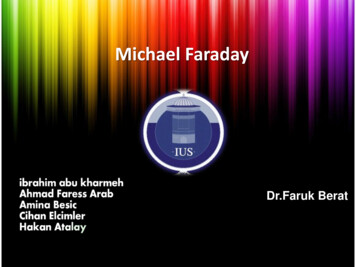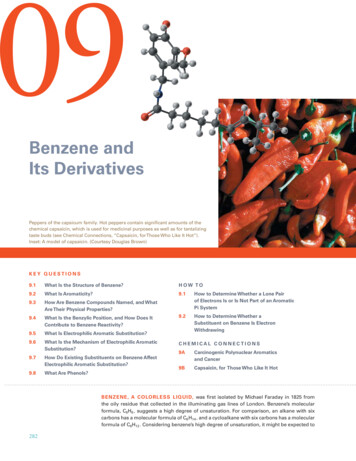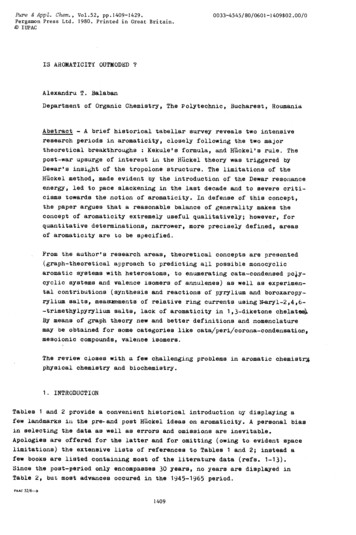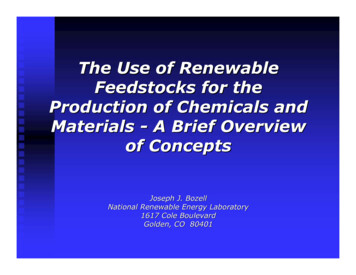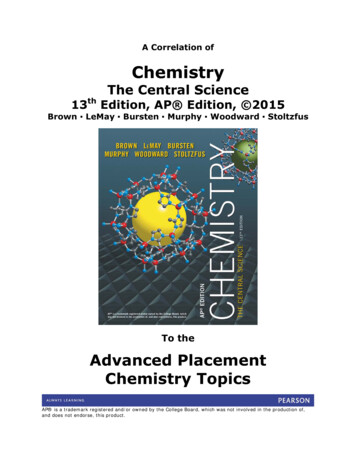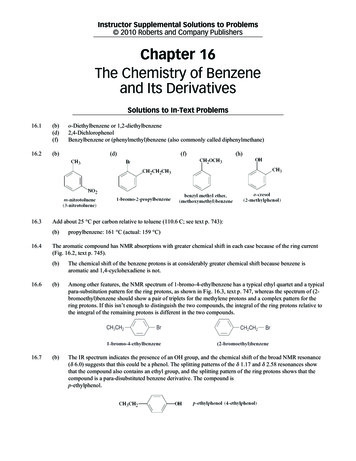
Transcription
Instructor Supplemental Solutions to Problems 2010 Roberts and Company PublishersChapter 16The Chemistry of Benzeneand Its DerivativesSolutions to In-Text Problems16.1(b)(d)(f)16.2(b)16.3Add about 25 C per carbon relative to toluene (110.6 C; see text p. 743):(b)16.4o-Diethylbenzene or 1,2-diethylbenzene2,4-DichlorophenolBenzylbenzene or (phenylmethyl)benzene (also commonly called diphenylmethane)(d)(f)(h)propylbenzene: 161 C (actual: 159 C)The aromatic compound has NMR absorptions with greater chemical shift in each case because of the ring current(Fig. 16.2, text p. 745).(b)The chemical shift of the benzene protons is at considerably greater chemical shift because benzene isaromatic and 1,4-cyclohexadiene is not.16.6(b)Among other features, the NMR spectrum of 1-bromo-4-ethylbenzene has a typical ethyl quartet and a typicalpara-substitution pattern for the ring protons, as shown in Fig. 16.3, text p. 747, whereas the spectrum of (2bromoethyl)benzene should show a pair of triplets for the methylene protons and a complex pattern for thering protons. If this isn’t enough to distinguish the two compounds, the integral of the ring protons relative tothe integral of the remaining protons is different in the two compounds.16.7(b)The IR spectrum indicates the presence of an OH group, and the chemical shift of the broad NMR resonance(d 6.0) suggests that this could be a phenol. The splitting patterns of the d 1.17 and d 2.58 resonances showthat the compound also contains an ethyl group, and the splitting pattern of the ring protons shows that thecompound is a para-disubstituted benzene derivative. The compound isp-ethylphenol.
INSTRUCTOR SUPPLEMENTAL SOLUTIONS TO PROBLEMS CHAPTER 16216.9Count the resonances. Mesitylene has three resonances; isopropylbenzene has six.16.11Because styrene has a double bond in conjugation with the ring and ethylbenzene does not, styrene has a greaterlmax in its UV spectrum.16.12Apply the steps shown in Eqs. 16.6–16.7 on text p. 752 to the para position of bromobenzene.16.14Apply the sulfonation mechanism shown in Eq. 16.13 on text p. 756 to the para position of toluene.16.16The product is tert-butylbenzene. The role of the Lewis acid BF3 is to promote the ionization of HF. The mechanismof the reaction is as follows:
INSTRUCTOR SUPPLEMENTAL SOLUTIONS TO PROBLEMS CHAPTER 1616.17(b)This is another example of an intramolecular Friedel–Crafts reaction—in this case, one that forms a sixmembered ring.16.18(b)16.19The two possible Friedel–Crafts reactions:16.21(b)Table 16.2 indicates that alkyl groups are ortho, para-directing groups, and the ethyl group is a typical alkylgroup:3
INSTRUCTOR SUPPLEMENTAL SOLUTIONS TO PROBLEMS CHAPTER 16416.22Let E be a general electrophile. The four resonance structures of the carbocation intermediate that results fromreaction of E at the position ortho to the methoxy group of anisole are as follows:16.24(b)The three strong carbon-fluorine bond dipoles result in substantial positive charge on the carbon of the CF3group; consequently, this is a meta-directing group.(d)The tert-butyl group, like all other alkyl groups, is an ortho, para-directing substituent.16.25(b)The reaction-free energy profiles for electrophilic substitution of benzene, nitrobenzene at the meta position,and nitrobenzene at the para position are shown in Fig. IS16.1. Notice that nitrobenzene is less reactive thanbenzene because the nitro group is a deactivating substituent. Notice also that meta-substitution reactions onnitrobenzene are faster than para-substitution reactions because the nitro group is a meta-directing group.16.27Bromination of N,N-dimethylaniline is faster because nitrogen has an unshared electron pair that can stabilize thecarbocation intermediate by resonance. As in the case of oxygen, the electron-withdrawing polar effect of nitrogen ismuch less important than its electron-donating resonance effect.16.28(b)As in part (a), each substituent is an ortho, para-directing group. Two products satisfy the directing effects ofboth groups.16.29(b)The order is anisole toluene chlorobenzene. Chlorobenzene requires the harshest conditions becausechlorine is a deactivating group. Anisole requires the mildest conditions because the methoxy group is moreactivating than the methyl group of toluene. (See Table 16.2 on text p. 763.)
INSTRUCTOR SUPPLEMENTAL SOLUTIONS TO PROBLEMS CHAPTER 16Figure IS16.1 Reaction-free energy profiles to accompany the solution to Problem 16.25(b)16.31(b)Hydrogenate tert-butylbenzene, which, in turn, is prepared by Friedel–Crafts alkylation as shown in Eq.16.18 on text p. 758 or by the reaction shown in the solution to Problem 16.16.5
INSTRUCTOR SUPPLEMENTAL SOLUTIONS TO PROBLEMS CHAPTER 166Solutions to Additional Problems16.33(a)(c)(b)No electrophilic aromatic substitution reaction takes place. Friedel–Crafts acylation does not take place onany benzene derivative less reactive than the halobenzenes. In fact, nitrobenzene can be used as an inertsolvent for Friedel–Crafts acylation.16.37Ethylbenzene has a three-proton triplet and, at somewhat greater chemical shift, in the benzylic proton region, a twoproton quartet. p-Xylene has a six-proton singlet in the benzylic region. Styrene, Ph—CHACH2, has no protons inthe benzylic region.16.38(b)16.40In each synthesis that involves substitution on a benzene derivative that contains an ortho, para-directing group, onlythe product resulting from para substitution is shown.(b)(d)(f)Fig. 16.2 on text p. 745 shows that aromatic protons located in the plane of the ring and outside of the ringexperience an augmented local field and thus a greater chemical shift. However, in the region above andbelow the ring, the induced field has the opposite direction, and consequently protons located in this regionexperience a reduced local field and thus a smaller chemical shift. Such is the case with the methyl group inthe problem; the local field at this group is so small that its resonance occurs at nearly 1.7 ppm smallerchemical shift than that of TMS.
INSTRUCTOR SUPPLEMENTAL SOLUTIONS TO PROBLEMS CHAPTER 167(h)Nitration of toluene actually gives more ortho isomer than para isomer of toluene, and the twonitrotoluene isomers are readily separated by fractional distillation. (See text p. 768.) o-Nitrotoluene is a good starting material for a number of ortho-substituted benzene derivatives.(j)Cyclopentanol may be substituted for cyclopentene in this synthesis, or chlorocyclopentane and AlCl3catalyst may be used instead of cyclopentene and H2SO4. Note that each of these possible starting materialsserves as a source of the same carbocation, the cyclopentyl cation.16.41(b)The reactivity order follows from the relative activating effects of the substituents. (See the last column ofTable 16.2 on text p. 763.)nitrobenzene chlorobenzene benzene(d)The reactivity order follows from the relative activating effects of the substituents. (See the last column ofTable 16.2 on text p. 763.)p-bromoacetophenone acetophenone p-methoxyacetophenone16.43The reactivity order is A B D C. Compound C is most reactive because the substituent has an unsharedelectron pair that can be used to stabilize the intermediate carbocation by resonance. Compounds B and D havealkyl substituents, which stabilize carbocations; however, the alkyl group of compound B contains a positivelycharged group that would interact unfavorably with a carbocation, offsetting the stabilizing effect of the alkylcarbon. Compound A has a positively charged, electronegative substituent attached directly to the ring that wouldinteract most unfavorably with the carbocation. (See the solution to Problem 16.42b.) Compounds C and D undergobromination at the ortho and para positions; compound A undergoes bromination at the meta position; and theposition of substitution in compound B depends on the balance of the stabilizing effect of the alkyl group and thedestabilizing effect of the positive charge. (In fact, this compound brominates in the ortho and para positions.)16.45The two possibilities are the acylation of anisole by benzoyl chloride (pair A), or the acylation of benzene by pmethoxybenzoyl chloride (pair B). Because the methoxy group activates electrophilic substitution at the ortho andpara positions, the Friedel–Crafts reaction of pair A should occur under the milder conditions.
INSTRUCTOR SUPPLEMENTAL SOLUTIONS TO PROBLEMS CHAPTER 168(Both reactions would work, however; and the use of pair B avoids the possibility of ortho substitution, although,with the Friedel–Crafts reaction, this does not generally occur to a great extent.)16.47Any compound must have an unsaturation number of 6 and must contain a benzene ring.Structures such as the one on the right that do not contain a benzene ring do not meet the criterion, because theywould undergo hydrogenation of the ring double bonds.16.50Run the electrophilic aromatic substitution reaction in reverse.There are several variations on this mechanism. For example, SO3H could be lost from the carbocation intermediateto give protonated SO3 (that is, SO3H; see Problem 16.13 on text p. 756) which could react with water to give SO3(sulfur trioxide) and H3O . Sulfur trioxide reacts vigorously with water to give H2SO4 (sulfuric acid). The importantaspect of the mechanism is the protonation of the ring and loss of a species which would serve as an electrophile inthe reverse reaction.16.52(a) and (b)Generation of the electrophile: The electrophile is the carbocation generated by protonation of the alcoholoxygen and loss of water.A Lewis acid–base association reaction of the benzene p electrons with the electrophile to generate anothercarbocation:Loss of a b-proton to the Brønsted base H2O to form the new aromatic compound:
INSTRUCTOR SUPPLEMENTAL SOLUTIONS TO PROBLEMS CHAPTER 16(c)9The aromatic ring of compound A has three alkyl substituents. Two of them—the tert-butyl group and one ofthe ring bonds—direct substitution by their electronic effects to the positions indicated by the asterisk:Electrophilic substitution might have occurred at either of these positions to give either or both of thecompounds shown in the foregoing equation. Both of these positions, however, are ortho to the very largetert-butyl group, and one of them is ortho to two highly branched groups. For steric reasons substitutioncannot occur at these very congested positions. Hence, it occurs at the remaining position. Note that ringposition meta to alkyl substituents are not deactivated; they are simply less activated than positions that areortho and para to alkyl substituents. Furthermore, the remaining ring position is activated by one alkylsubstituent.16.58(c)The following two products derived from nitration of compound C were probably formed in smallest amount.In the formation of compound C1, the nitro group and the two bromines are involved in severe van der Waalsrepulsions; and the formation of compound C2 satisfies the directing effect of neither bromine substituent.16.59(b)The formula indicates that successive electrophilic aromatic substitution reactions have occurred; the productis triphenylmethane, Ph3CH.Comparison of the formula of the product to that of naphthalene shows that one molar equivalent of theacylating agent has been introduced. Since there is no chlorine in the product, the reaction must involve adouble acylation of the naphthalene ring by both ends of the acid chloride. The only way that this can occurwith the formation of rings of reasonable size is for the acylation to occur across ortho positions of onebenzene ring, or across the peri positions, which are the two positions on either side of the ring junction.These three possibilities account for the three products:(d)
INSTRUCTOR SUPPLEMENTAL SOLUTIONS TO PROBLEMS CHAPTER 1610(g)The nitro group is directed by both substituents to the position ortho to the methoxy group, and the brominein the second reaction is directed to the other position ortho to the methoxy group.16.60(b)When nitration occurs at carbon-5, the unshared electrons of the oxygen can be used to stabilize thecarbocation intermediate by resonance; consequently, nitration at carbon-5 of 1-methoxynaphthalene is fasterthan nitration of naphthalene itself.16.64In this reaction a tert-butyl cation is lost rather than a proton from the carbocation intermediate. The electrophile, anitronium ion NO2, is generated by the mechanism shown in Eqs. 16.11a–d on text p. 755.
16.58 (c) The following two products derived from nitration of compound C were probably formed in smallest amount. In the formation of compound C1, the nitro group and the two bromines are involved in severe van der Waals repulsions; and the formation of compound C2 satisfies the directin






